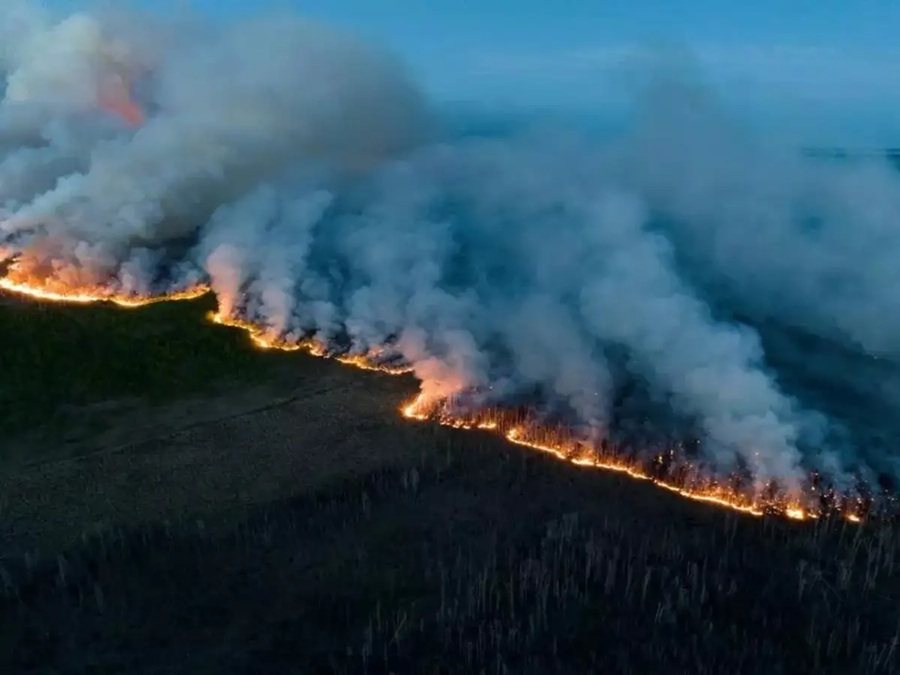June 2025 – Once again, smoke from massive wildfires burning across Canada has made its way into the United States, prompting air quality alerts from the Midwest to the East Coast. The hazy skies and acrid smell are becoming a familiar sight to millions of Americans as climate-fueled wildfire seasons grow longer and more intense.
Smoke Drifts South, Millions Affected
As of early June, over 150 wildfires are burning across several Canadian provinces, including Alberta, British Columbia, and Quebec. The fires have already scorched millions of acres of forest, and with strong winds blowing southward, the smoke has blanketed major U.S. cities like Chicago, Detroit, New York City, and Washington, D.C.
The U.S. National Weather Service and Environmental Protection Agency (EPA) have issued air quality alerts in more than 20 states, urging residents—especially children, the elderly, and people with respiratory conditions—to limit outdoor activities. In many affected areas, the Air Quality Index (AQI) has reached levels considered “unhealthy” or even “very unhealthy.”
In New York City, officials advised residents to wear masks when outdoors and to keep windows closed. Schools in parts of Pennsylvania and Ohio held indoor recess. In Washington, D.C., the haze visibly dulled the skyline, with iconic monuments barely discernible through the thick smoke.
What’s Causing the Fires?
The wildfires in Canada are largely being fueled by dry conditions, record-high temperatures, and lightning strikes, all of which have become more common due to climate change. Canada’s wildfire season now starts earlier and ends later, mirroring trends seen in the American West.
Experts from Canada’s Natural Resources agency have pointed out that 2025 is shaping up to be one of the worst wildfire years on record, surpassing even the devastating 2023 and 2024 fire seasons. “We are witnessing a dangerous combination of dry vegetation, heat, and strong winds,” said Dr. Lena McAllister, a wildfire climatologist. “The result is not just a local crisis, but one with far-reaching effects.”
How Dangerous Is Wildfire Smoke?
Wildfire smoke contains a mix of gases and fine particles known as PM2.5, which can penetrate deep into the lungs and even enter the bloodstream. Exposure to PM2.5 has been linked to a range of health problems, including asthma, bronchitis, heart disease, and premature death.
Dr. Anthony Sutherland, a pulmonologist at Johns Hopkins Medicine, warns that “Even healthy people can experience symptoms like coughing, sore throat, headaches, and fatigue after exposure to wildfire smoke. For people with underlying conditions, the risks are much greater.”
Hospitals in cities such as Cleveland, Buffalo, and Baltimore have reported an uptick in patients seeking care for respiratory issues in the last 72 hours.
Flights Delayed, Events Canceled
The smoke isn't just impacting health—it’s also affecting transportation and public events. Dozens of flights were delayed or canceled out of major airports in Chicago and Boston due to low visibility. Outdoor events including concerts, farmers markets, and sports games were postponed across the Northeast and Midwest.
The New York Philharmonic canceled a planned outdoor performance in Central Park, citing health concerns for both musicians and attendees. Meanwhile, the Detroit Tigers delayed a home game due to poor air quality at Comerica Park.
What You Can Do to Stay Safe
Health officials recommend several steps to protect yourself during periods of poor air quality:
Check local air quality reports on sites like airnow.gov
Stay indoors with windows and doors closed
Use air purifiers or run air conditioning with clean filters
Avoid strenuous outdoor activities
Wear an N95 mask if you need to be outside for extended periods
If you have asthma, COPD, or heart disease, be especially vigilant and ensure you have an adequate supply of medication.
A New Normal?
For many Americans, the wildfire smoke drifting from Canada is more than just an inconvenience—it’s a sign of a rapidly changing environment. In recent years, we’ve seen that no region is immune to the effects of wildfires, even if the flames themselves are hundreds of miles away.
According to the U.S. Forest Service, smoke from wildfires—both domestic and international—is becoming one of the biggest air pollution threats facing the country. The agency is investing in new forecasting tools and early warning systems, but there's growing concern that these efforts may not keep pace with the climate-driven uptick in wildfires.
“This is not a one-off event,” said EPA Administrator Michael Regan during a press briefing. “This is a trend, and it's likely to get worse unless we take meaningful action on climate resilience and emissions reduction.”
Final Thoughts
As the summer of 2025 kicks off, millions of Americans are once again facing the health and lifestyle disruptions that come with wildfire smoke. While the fires may be burning north of the border, their impacts don’t stop at national boundaries. The haze in the sky is a stark reminder that we live in an interconnected ecosystem—one where climate change knows no borders.
For now, staying informed and prepared is key. But over the long term, it will take coordinated action—from governments, communities, and individuals—to address the root causes of the increasingly smoky skies overhead.
